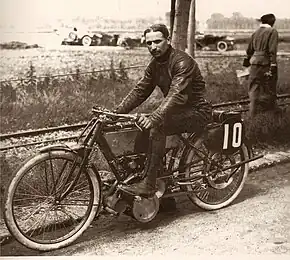Peugeot 500 M
The Peugeot 500 M (1913-1914) was a French racing motorcycle designed by Ernest Henry in 1913. It was a "technical tour de force" as the first motorcycle ever designed with a dual overhead camshaft. It also used a multi-valve cylinder head, with four valves per cylinder.[2][3]
 Peugeot race team rider Paul Péan on a 500 M | |
| Manufacturer | Peugeot |
|---|---|
| Production | 1913–1914 |
| Engine | 495 cc Parallel twin, 4-valve per cylinder gear-driven dual overhead cam |
| Bore / stroke | 62 × 82 mm[1] |
| Top speed | c. 122 km/h (76 mph) |
| Power | 15 hp (11 kW)[1] |
| Transmission | Primary: chain Final: Belt (probably leather) |
| Suspension | Front: girder fork Rear: rigid |
| Brakes | Pedal-operated drum |
Development and technology
The Swiss engineer Ernest Henry adapted his incredibly successful Peugeot four-cylinder automobile racing engine (1912) for a racing motorcycle.[4] The 500M used a parallel twin-cylinder engine, with dual overhead camshafts driven by a cascade of gears between the cylinders, with four-valve cylinder heads. The 500M was the most technically advanced motorcycle in the world when introduced. However, the design was ahead of the metallurgy available at the time, and suffered from cracking between the valve seats. [5]
While the engine was incredibly advanced, power transmission was a single speed via direct belt drive.[2] At the rear wheel the Peugeot had a pedal-operated drum brake. Front suspension was a girder fork.[6]
Test drives
Peugeot proved the reliability of the motor bike in test runs conducted in 1913. The racing motorcycle reached a world record of 122.2 km/h (75.9 mph) over the flying kilometre for its displacement class.[7] The company entered reliable and proven two-cylinder V-engines with simple valve actuation in the 1913 French motorcycle Grand Prix. The machine was raced at various venues, but its full potential was thwarted due to the First World War.
Later redesigns
Peugeot resumed development in 1919 of Henry's original 1913/4 design. Major redesigns were executed by Marcel Grémillon in 1919 who moved the DOHC gear drive to the side of the engine, and a 3-speed gearbox with clutch. Lessman Antonesco altered the design again in 1923, changing the design to a simpler OHC, 2-valve motor with the camshaft driven by shaft-and-bevel. This proved the fastest and most reliable variant of all, but by 1925, Peugeot separated its motorcycling and automotive divisions, and the GP twin project was abandoned.[8]
2010 reproduction
For the 100th anniversary of the model, an electronics engineer named Jean Boulicot built a reproduction between c. 2000 and 2010 from Henry's original blueprints, using a home lathe and milling machine.[9]
The reproduction machine was displayed at Salon Rétromobile 2010.[10]
See also
References
Notes
- Walker 2006, p. 23.
- d'Orléans 2010.
- Cathcart 2011.
- Apfelbeck 1997, p. 13.
- Rey & Louis 1977, p. 48.
- Bourdache, Jean (1989). La Motocyclette en France 1894-1914. Edifree, Paris, 1989
- Huse 1999, p. 52.
- Jardy, Alain (2013). 'Peugeot 500 GP 1914', RAD Magazine, Oct, 2013
- Dumas 2012, p. 136.
- Girardin 2010.
Sources
- Rey, Christian; Louis, Harry (1977), Berühmte Motorräder: 1896 - 1950 [Famous Motorcycles: 1896-1950], Heyne, ISBN 3-453-52062-9
- Apfelbeck, Ludwig (1997), Wege zum Hochleistungs-Viertaktmotor [Pathways to the high performance four-stroke engine], ISBN 3-87943-578-2
- Huse, Hans Jürgen (1999), Französische Motorräder [French motorcycles], ISBN 39804987-6-X
- d'Orléans, Paul (January 26, 2010), "Peugeot Racers: Part 1", The Vintagent
- Girardin, Pascal (January 27, 2010), "Peugeot au Rétromobile 2010 : les 500 de Grand-Prix", Moto (in French)
- Walker, Mick (2006), Motorcycle: Evolution, Design, Passion, Johns Hopkins University Press, ISBN 0801885302
- Cathcart, Alan (2011), "1922 Peugeot Grand Prix racer", Motorcycle Classics, July–August
- Dumas, François-Marie (2012), "Peugeot Grand Prix 500: Twin-cylinder bikes to change the world", Unusual Motorcycles, Haynes Publishing Group, pp. 134–145, ISBN 978-0857332615
